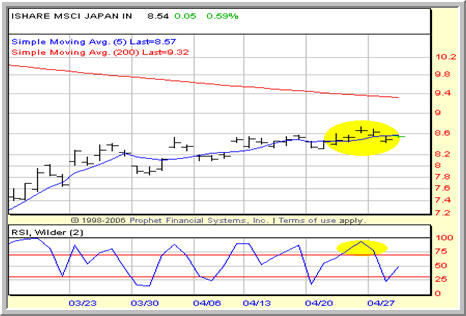Battle Plan Trade of the Week: Turning Japanese with EWJ
High probability trading means that while the majority of trades will be profitable, some trades will net smaller gains than others.
This is the way of high probability trading: like small ball in baseball, we take bunts, singles, and even make the occasional sacrifice fly just to get the runners around the bases. It may not be as glamorous as a big swinging home run hitting strategy. But as we know, swinging for the fences every time at the plate can lead to a healthy number of strikeouts. We would rather accumulate the hits — and the runs — patiently, inning by inning.
Our most recent Daily Battle Plan trade was an example of this Ichiro-like small ball. We spotted the iShares MSCI Japan Index ETF
(
EWJ |
Quote |
Chart |
News |
PowerRating) moving into overbought territory below the 200-day late last week along with the broader market. EWJ was one of the more overbought country ETFs at the time, and our strategy, as always, is to increase our position size in the overbought ETF as it moved higher and deeper into overbought territory.
As it turned out, we were only able to get the first of potentially three units sold short in EWJ. And our holding time in the ETF short trade was relatively short. We got short in the EWJ on Friday, April 24 at the close and, by Tuesday’s close, the EWJ had moved lower to close below its 5-day moving average — our standard exit signal.

This quick short trade was not our biggest gainer in the Daily Battle Plan. Traders who exited on Tuesday gained around 1.88%. But what is worth noting is the fact that this most recent trade was our 16th profitable trade for the year out of a total of 17 trades. And as incredible as this string of successful trades is (we are at 94% correct in 2009), it is the kind of success that we, as high probability traders, expect from our trading strategies and methods.
Every day in our Battle Plan we’ll provide you with incisive, before-the-bell commentary and analysis on the day’s markets to help put your trading in context. We’ll give you suggested entries and exits for short term trading opportunities in stocks, ETFs and options that may be only hours away. And we’ll give you what many other people can’t: model-driven percentages so that you know the historical win rate going back to 1995 for every single trade idea—
